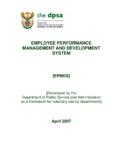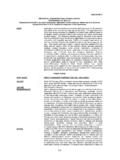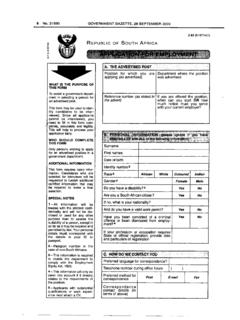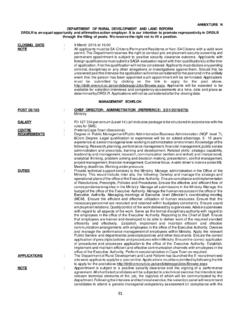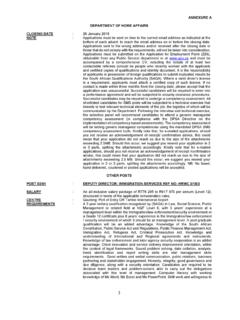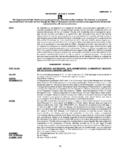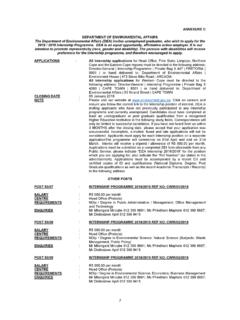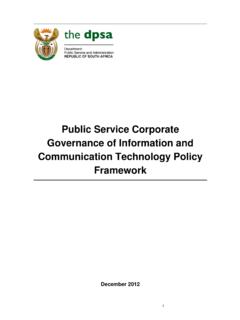Transcription of CHAPTER 4 PERFORMANCE MANAGEMENT AND …
1 SMS Handbook CHAPTER 4 performance management and development 01/04/2006 CHAPTER 4 performance management and development 1. INTRODUCTION This CHAPTER describes the process and requirements of PERFORMANCE MANAGEMENT and development for members of the SMS. It is issued as a directive by the Minister for the Public Service and Administration (MPSA) in terms of Part of CHAPTER 4 of the Public Service Regulations, 2001 (PSR) and replaces circular 2/3/1/1/P of 12 May 1999 and the Handbook MANAGEMENT of PERFORMANCE Agreements.
2 In as far as national heads of department (HoDs) are concerned, this CHAPTER should be applied in conjunction with the system for the evaluation of HoDsand guidelines issued by the Office of the Public Service Commission. The same applies to those provincial administrations that have adopted the national HoD evaluation system for their provincial HoDs. The PERFORMANCE MANAGEMENT and development system is summarised at Annexure A. 2.
3 PURPOSE The CHAPTER aims to: (1) Consolidate the provisions regarding PERFORMANCE MANAGEMENT and development (PM&D) for the SMS that must be applied by departments; (2) Provide guidance on linking the SMS Competency Framework that guides recruitment, selection and development with regard to the MANAGEMENT of SMS PERFORMANCE ; (3) Encourage and further develop good practice in the MANAGEMENT and development of the SMS based on an assessment of existing practice and the feedback obtained from members during consultation processes; (4) Create a better understanding of the context and best practice parameters for implementing PM&D for the SMS.
4 (5) Give guidance on the implementation and MANAGEMENT of PAs within the context of a PM (6) Explain and illustrate the critical areas of a PM&D cycle that links with related HR - systems; and SMS Handbook CHAPTER 4 performance management and development 01/04/2006 2(7) Suggest the conditions that departments will need to create in order to manage PERFORMANCE effectively. 3. DATE OF IMPLEMENTATION The PMDS was introduced 1 April 2002 and amended 1 April 2006.
5 4. KEY PRINCIPLES The key principles underpinning the effective implementation of PM&D are outlined in the PSR. These principles are captured below. For details, departments must refer to the relevant sections of the PSR (Part VIII A of CHAPTER 1) and the Handbook - PERFORMANCE MANAGEMENT and development (August 2000). The principles are: (1) Departments shall manage PERFORMANCE in a consultative, supportive and non-discriminatory manner in order to enhance organisational efficiency and effectiveness, accountability for the use of resources and the achievement of results; (2) PERFORMANCE MANAGEMENT processes shall link to broad and consistent staff development plans and align with the department s strategic goals.
6 (3) PERFORMANCE MANAGEMENT processes shall be developmental, but shall allow for effective response to consistent inadequate PERFORMANCE and for recognising outstanding PERFORMANCE [including demonstration of agreed CMCs]; and (4) PERFORMANCE MANAGEMENT procedures should minimise the administrative burden on supervisors (and members of the SMS) while maintaining transparency and administrative justice. 5. REGULATORY FRAMEWORK PERFORMANCE MANAGEMENT in the public service is guided by the Act, the PSRs, resolutions of the Public Service Co-ordinating Bargaining Council (PSCBC), the Treasury Regulations, 2001 and the Batho Pele White Paper.
7 SMS Handbook CHAPTER 4 performance management and development 01/04/2006 3(1) Public Service Act, 1994 (a) Section 3 (5): Assigns powers and duties concerning the internal organisation of a department to its EA. This includes: The determination and grading of the post establishment; and The career incidents of employees other than HoDs, such as PERFORMANCE MANAGEMENT and discipline in a department. (b) Section 3 B: Assigns the President and relevant Premiers the powers and duties concerning the appointment and other career incidents of HoDs, which may be delegated.
8 (c) Section 7(3)(b): Provides for the following responsibilities of HoDs: Efficient MANAGEMENT and administration Effective utilisation and training of staff Maintenance of discipline Promotion of sound labour relations Proper use and care of state property (d) Section 12(4)(b): Provides for the inclusion, by mutual agreement, of specific PERFORMANCE criteria for evaluating the PERFORMANCE of the HoD. (2) Public Service Regulations, 2001 (a) Paragraph of Part VII, CHAPTER 1: Indicates that the prescribed employment contract of an HoD shall be as set out in Annexure 2 of the PSR.
9 (b) Paragraph 7 of the employment contract (Annexure 2): Contains the measures that govern the PA of an HoD. (c) Paragraph of Part VIII, CHAPTER 1: Indicates that an EA shall determine a system for PERFORMANCE MANAGEMENT for employees in her/his department other than employees in the SMS. This implies that the MPSA should determine such a system for members of the SMS. SMS Handbook CHAPTER 4 performance management and development 01/04/2006 4(d) CHAPTER 4 provides for the establishment of the SMS.
10 Paragraph A, Part III states that the PERFORMANCE of all members of the SMS will be managed through a PA, which should be linked to the department s strategic plan. Paragraph B states that all new members of the SMS shall enter into a PA, which will define key responsibilities and priorities, encourage improved communication and enable the supervisor to assess the work of the member of the SMS. (3) PSCBC Resolution No 13 of 1998 (a) The resolution states that the purpose of the negotiated collective agreement is to set a framework for senior managers to agree to individual PAs.
